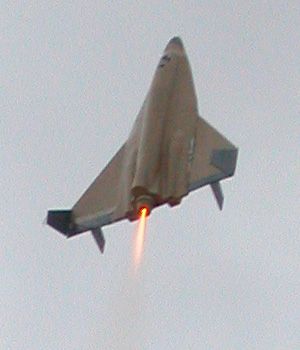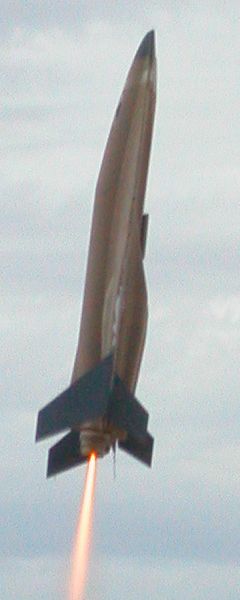| Construction Rating: | starstarstarstarstar_border |
| Flight Rating: | starstarstarstarstar_border |
| Overall Rating: | starstarstarstarstar_border |

Brief:
The Estes Cosmos Mariner is a 1:67 scale version of the Lone Star Space Access
team rocket plane for the X-Prize. It is a single stage D12-3 power glider with
pop-pod on 18" parachute recovery.
Construction:
1 main body tube with 24mm pop-pod insert. The pop-pod have centering rings
that fit the body tube and 4 heavy washers for nose weight on boost. Flat wing
glider is made from 6 laser cut wing panels. There are also 4 fins (rudders).
The rest of the body is made from two large vacuumed form sheets of plastic.
There are three display engine nozzles that come off for flight.
The instructions are easy to follow and the illustrations are good. You must have a good flat surface to build the wing. The wing consists of 6 large sections of balsa, 3 for each half of the glider wing. It is very important to have all pieces glue together flat. The hardest part was gluing on the two vacuum form body sections. The body sections didn't fit the assembly well. The instructions call for using a silicon adhesive. I used GE Silicone II. You have to wipe away any excess glue as you cannot sand it later. I was not impressed with the glue joint. If I had to do it again, I would use a thick super glue for plastics.
Finishing:
No special requirements for finishing. The balsa wings need a lot of sanding
sealer to get smooth. The paint scheme is easy. There are a few stick on type
decals.
Construction Rating: 4 out of 5

Flight:
The only recommended motor is the D12-3. The model boosts nicely with a slow
roll during boost. It is important when flying to make sure that the elastic
that pops up one elevator is attached well and when the pop-pod is inserted,
the movable elevator is facing the opposite direction of the glued on elevator.
This is what rolls the model during boost. Once the pop-pod ejects, the movable
elevator pops up to get the plane into glide configuration. This glider is hard
to balance. Even with glider at the specified balanced point, the glider stills
stalls in flight. It is hard to test glide it since it a fairly heavy glider.
It will take quite a few flights to trim out the glider. One person mentioned
to me that even though it was stalling, it was one of the best glides he seen
out of this kit.
Recovery:
I flew this model as a entry in SF/FF event at NARAM 48. On the first flight,
the parachute on the pop-pod got tangled in the wire hook on the back of the
pop-pod and never really opened, so it came streaming into the ground. The RSO
DQed the flight as unsafe. The pop-pod with all those washer is very heavy, so
it is important safety wise to make sure the chute will always open. On the
second flight, I got rid of the Estes supplied chute and use a nylon chute of
the same size. I also shortened the shroud lines and taped them to the pop-pod
way from the wire hook in the back so there was no chance of them snagging on
the wire. On the first landing, both wings cracked down the wing grain of the
balsa to a point outside the lower rudders. This was repaired with super glue
and flown again. Admittedly the ground at NARAM was hard packed and there was
no grass to cushion the landing. I am sure landing on macadam or concrete would
also be very bad for this glider, so avoid flying it near paved areas.
Flight Rating: 4 out of 5
Summary:
I like this glider even thought it is on the heavy side. Most of the glider
seems right on except for the back where the engine goes. On the picture on the
package, it has the engine sitting inside the three display nozzles, however,
when you build it, the display nozzles come off and leave an ugly gap where the
body wrap doesn't quite fit around the body tube. I am guessing the original
plan was to have the display nozzles and backing on the pop-pod for flight but
was given up during the kit release. I think it is possible to grind out the
display backing to fit the pop-pod with the display nozzles but that is
something for another time.
Overall Rating: 4 out of 5
Other Reviews
- Estes Cosmos Mariner By Chan Stevens
This X-Prize scale rocket showed good potential and an intriguing stealthy boost glider design, but save your money though, as it's a real clunker for flight. Parts list includes: BT-55 fuselage tube BT-50 motor tube/pod tube Laser cut fins Molded plastic upper and lower halves Plastic display nozzles/nozzle base 18" plastic chute Assorted centering rings and ...
 |
 |
Flights
 |
 |
D.A.B. (July 9, 2006)
D.S.M. (July 23, 2010)
 |
 |

F.S.W. (May 8, 2006)